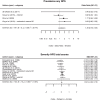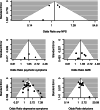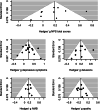Sex differences in neuropsychiatric symptoms in Alzheimer's disease dementia: a meta-analysis
- PMID: 35379344
- PMCID: PMC8978393
- DOI: 10.1186/s13195-022-00991-z
Sex differences in neuropsychiatric symptoms in Alzheimer's disease dementia: a meta-analysis
Abstract
Background: Neuropsychiatric symptoms (NPS) are common in individuals with Alzheimer's disease (AD) dementia, but substantial heterogeneity exists in the manifestation of NPS. Sex differences may explain this clinical variability. We aimed to investigate the sex differences in the prevalence and severity of NPS in AD dementia.
Methods: Literature searches were conducted in Embase, MEDLINE/PubMed, Web of Science Core Collection, Cochrane Central Register of Controlled Trials, PsycINFO, and Google Scholar from inception to February 2021. Study selection, data extraction, and quality assessment were conducted in duplicate. Effect sizes were calculated as odds ratios (OR) for NPS prevalence and Hedges' g for NPS severity. Data were pooled using random-effects models. Sources of heterogeneity were examined using meta-regression analyses.
Results: Sixty-two studies were eligible representing 21,554 patients (61.2% females). The majority of the included studies had an overall rating of fair quality (71.0%), with ten studies of good quality (16.1%) and eight studies of poor quality (12.9%). There was no sex difference in the presence of any NPS (k = 4, OR = 1.35 [95% confidence interval 0.78, 2.35]) and overall NPS severity (k = 13, g = 0.04 [- 0.04, 0.12]). Regarding specific symptoms, female sex was associated with more prevalent depressive symptoms (k = 20, OR = 1.60 [1.28, 1.98]), psychotic symptoms (general psychosis k = 4, OR = 1.62 [1.12, 2.33]; delusions k = 12, OR = 1.56 [1.28, 1.89]), and aberrant motor behavior (k = 6, OR = 1.47 [1.09, 1.98]). In addition, female sex was related to more severe depressive symptoms (k = 16, g = 0.24 [0.14, 0.34]), delusions (k = 10, g = 0.19 [0.04, 0.34]), and aberrant motor behavior (k = 9, g = 0.17 [0.08, 0.26]), while apathy was more severe among males compared to females (k = 11, g = - 0.10 [- 0.18, - 0.01]). There was no association between sex and the prevalence and severity of agitation, anxiety, disinhibition, eating behavior, euphoria, hallucinations, irritability, and sleep disturbances. Meta-regression analyses revealed no consistent association between the effect sizes across studies and method of NPS assessment and demographic and clinical characteristics.
Discussion: Female sex was associated with a higher prevalence and greater severity of several specific NPS, while male sex was associated with more severe apathy. While more research is needed into factors underlying these sex differences, our findings may guide tailored treatment approaches of NPS in AD dementia.
Keywords: Alzheimer’s disease; Behavioral and psychological symptoms of dementia; Behavioral symptoms; Meta-analysis; Neuropsychiatry; Sex.
© 2022. The Author(s).
Conflict of interest statement
The authors declare that they have no competing interests.
Figures






References
-
- Garre-Olmo J, López-Pousa S, Vilalta-Franch J, de Fracia BM, Bulbena VA. Grouping and trajectories of neuropsychiatric symptoms in patients with Alzheimer’s disease. Part II: two-year patient trajectories. J Alzheimers Dis. 2010;22:1169–1180. - PubMed
-
- Clayton JA, Tannenbaum C. Reporting sex, gender, or both in clinical research? JAMA. 2016;316:1863–1864. - PubMed
-
- Alzheimer’s Association 2021 Alzheimer’s disease facts and figures. Alzheimers Dement. 2021;17(3):327–406. - PubMed
Publication types
MeSH terms
LinkOut - more resources
Full Text Sources
Medical

